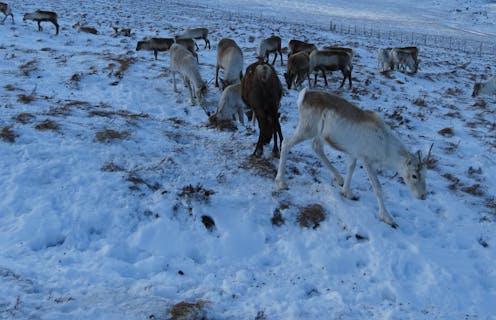Reindeer eyes change color, putting Rudolph's red nose in the shade – new research podcast
- Written by Daniel Merino, Associate Science Editor & Co-Host of The Conversation Weekly Podcast, The Conversation

Reindeers’ noses may not glow red, but these creatures of cold climes have evolved the ability to change the color of their eyes to help them thrive in dark, northern winters. In this Discovery episode, we speak with Glen Jeffery[1], a professor of neuroscience at the Institute of Opthamology at UCL (University College London) in the U.K. about what makes reindeer eyes truly unique in the animal kingdom.
Most people have seen the gold, glowing eyes of a cat, a raccoon or some other nocturnal animal staring back at them during a nighttime drive. The part of the eye that produces that golden reflection, as Jeffery explains, “is a mirror that lots of animals have called the tapetum lucidum.” A taptetum helps animals see better in the dark by bouncing light from the back of the eye through the retina a second time. In most mammals, the tapetum is a “standard golden,” as Jeffery describes the color, and that color doesn’t change.
One day, Jeffery received a box in the mail out of the blue. It contained two jars filled with reindeer eyes from a slaughterhouse in Norway. One jar was labeled summer and one was labeled winter.
“I opened up the summer ones first and I thought, ‘I’m wasting my time here,’” says Jeffery. He saw golden eyes, just what he expected.
“But then we opened up the other eyes, and that was when there was a shock, because the winter eyes were blue,” he said. “I’d never seen anything like that in my life.”
Jeffery and his colleagues spent years studying the biology of reindeer eyes and the environment they are made for – the dim, blue-hued months of the Arctic winter. What they discovered is a marvelous bit of evolution that has given reindeer some of the most interesting eyes on Earth. Listen to this Discovery episode of the Conversation to hear about how Jeffery and his colleagues study reindeer eyes, why winter eyes are such a unique color and how light pollution can alter this finely tuned adaptation.
This episode was produced by Katie Flood and hosted by Dan Merino. The interim executive producer is Mend Mariwany. Eloise Stevens does our sound design, and our theme music is by Neeta Sarl.
You can find us on Twitter @TC_Audio[3], on Instagram at theconversationdotcom[4] or via email[5]. You can also sign up to The Conversation’s free daily email here[6]. A transcript of this episode will be available soon.
Listen to “The Conversation Weekly” via any of the apps listed above, download it directly via our RSS feed[7] or find out how else to listen here[8].
References
- ^ Glen Jeffery (scholar.google.com)
- ^ Bowlhover/Wikimedia Commons (commons.wikimedia.org)
- ^ @TC_Audio (twitter.com)
- ^ theconversationdotcom (www.instagram.com)
- ^ via email (theconversation.com)
- ^ free daily email here (theconversation.com)
- ^ RSS feed (feeds.acast.com)
- ^ how else to listen here (theconversation.com)
Authors: Daniel Merino, Associate Science Editor & Co-Host of The Conversation Weekly Podcast, The Conversation

